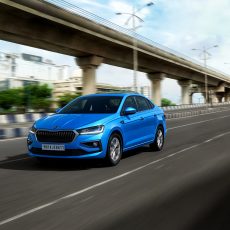


THE HISTORY OF THE AUDI FEATURE A6
THE A6 STORY:
FROM DESIGN BOARD TO ROAD
The inter-continental journey of the German marque to India
ALBRECHT REIMOLD
Plant Manager
Audi Neckarsulm, Germany
CAR INDIA: How many people are involved in the production
of the A6?
ALBRECHT REIMOLD: 3,000 employees work in three
shifts at the Audi A6 assembly shop.
CI: What is the capacity of the German factory?
AR: The Audi A6 is built in Neckarsulm. The Neckarsulm
plant has a capacity of 1,150 vehicles per day (including all
models produced on site).
CI: Can you share some details about the quality check that each
car has to undergo before it rolls out of the plant?
AR: Function testing, electronic testing, quality control and
road testing.
CI: Are there any hand-crafted parts in the interior of the A6?
AR: Seats, centre console panels, door trim panels and all the
exclusive Audi items.
CI: Where are the engines procured from?
AR: All engines are produced at the Audi engine plant in
Györ, Hungary.
The Audi A6, originally launched as the C100 way back in 1968, has a chequered history spanning its seven generations. In its standard trim, the C100 developed 80 PS of peak power while the 100S developed 90 PS. More significantly, the C100 weighed just a little more than far smaller models in Audi’s stable, possessed an excellent power-to-weight ratio and had a remarkable drag coefficient of 0.369, thus making every drop of fuel go the extra mile. In the autumn of 1970, Audi launched the sportier Audi 100 Coupé S with 111 PS of peak power and topped off the range with the luxury sports saloon, the 100GL . In all, Audi built more than 8,00,000 units of the100, including about 30,000 coupés.
Sensing that they were on to a good thing, Audi promptly released the secondgeneration 100 in 1976. Whereas the focus of the first model was on a technically refined product with long-lasting style and technology, the developers laid greater emphasis on producing a family vehicle that could be used worldwide (with a wide variety of options) for the secondgeneration model. The new iteration featured bigger lights all-round and an overall new look. It also boasted of Audi’s first mass produced five-cylinder fuelinjected engine with a peak power figure of 136 PS. The two-door model was launched the following year. However, it was eclipsed greatly by the widely successful 100 Avant that followed later that year. An absolute top-end model, the Audi 200 came soon thereafter.
The fuel scare of the 1980s saw manufacturers scramble back to their drawing boards, churning out revolutionary new ideas that made every extra litre go that extra mile. Audi took the obvious route – lightening the thirdgeneration
100 and tweaking the aerodynamics as far as physics would allow. The result, a drag coefficient of just
0.3, earned the new car the title of ‘aerodynamic world champion’ of its time. A fourth-generation 100 and quattro
permanent four-wheel drive followed in 1990 and so did the ‘S’ label, signifying particularly sporty and high-performance models in the line-up.
1 The Audi C100, the original precursor to the current A6
2 For the second generation, the developers laid greater emphasis on producing a family vehicle that could be used worldwide
3 Fuel efficiency was the most important factor in the development of the third gen 100
4 Quattro made its debut in the fourth generation
5 Audi’s first six-cylinder TDI engine made its world debut in the fifth generation
6 The sixth generation A6 continues Audi’s tradition of sterling German solidity and classbeating efficiency
In the mid-1990s, Audi changed the model name to A6, highlighting their claim as a progressive and premium brand. The fifth generation, launched in 1997, brought with it a host of new engine options and features, such as the world début of the first six-cylinder TDI engine and the Multitronic CVT. Now in its seventh generation, the new Audi A6, still built in the original factory premises in Neckarsulm, Germany, and assembled as a CKD unit in Aurangabad, India, continues the tradition of sterling German solidity and class-beating efficiency, all seamlessly merged into a luxurious, aesthetically beautiful luxury sedan.




